Phuket, which is marketed as the ‘Pearl of the Andaman’ reflecting its shape as well as its physical beauty, has been transformed over the past three decades from a sleepy little island into the country’s most popular beach destination. It receives an escalating volume of visitors currently standing at around thirty million each year. It is Thailand’s smallest province but largest island, at 587 sq km (225 sq miles), and has hotels to suit all budgets, including huge luxury resorts, expensive boutique properties, and upmarket villa-style houses. There has also been a condominium boom, along with shops, schools and hospitals of international standard, which unsurprisingly has encouraged many foreigners to take up permanent residence here.
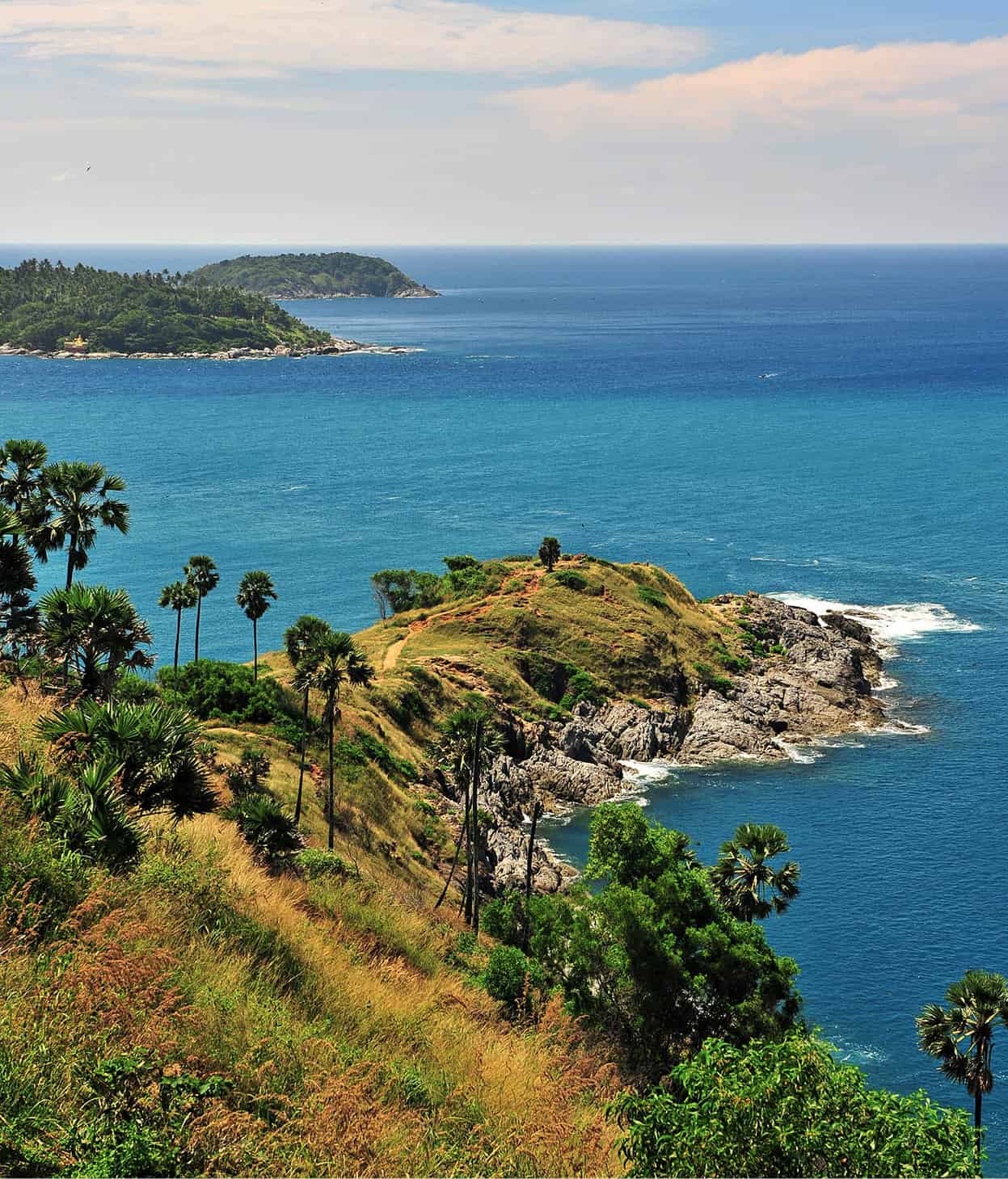
Laem Promthep.
Dreamstime
The stunning white-sand beaches along the 48km (30-mile)-long west coast are separated by picturesque headlands. Some are small and pristine with intimate hidden coves, while others teem with noisy jet-skis, crowds of sun-worshippers, and vendors trawling the sands selling colourful sarongs and souvenirs.
Phuket is a base for trips to several renowned dive sites in the surrounding seas, and the number of operators offering courses, organised excursions and live-aboards is astounding. Phuket is also an excellent base for the exploration of islands, national parks and mainland beaches such as Khao Lak and Krabi.
People and economy
Of the approximately 387,000 people living on Phuket, the majority are Buddhist, with Muslims comprising around 35 percent. Many locals make their living from the island’s rubber and pineapple plantations, but since the 1980s, tourism has overtaken agriculture as the main source of income. There are several tourist-related theme parks and activity centres, such as Siam Niramit, and visitors enjoy a good choice of international and Thai restaurants. And the shopping scene has never been better, with malls such as Central Festival Phuket bringing chic brands to the island.
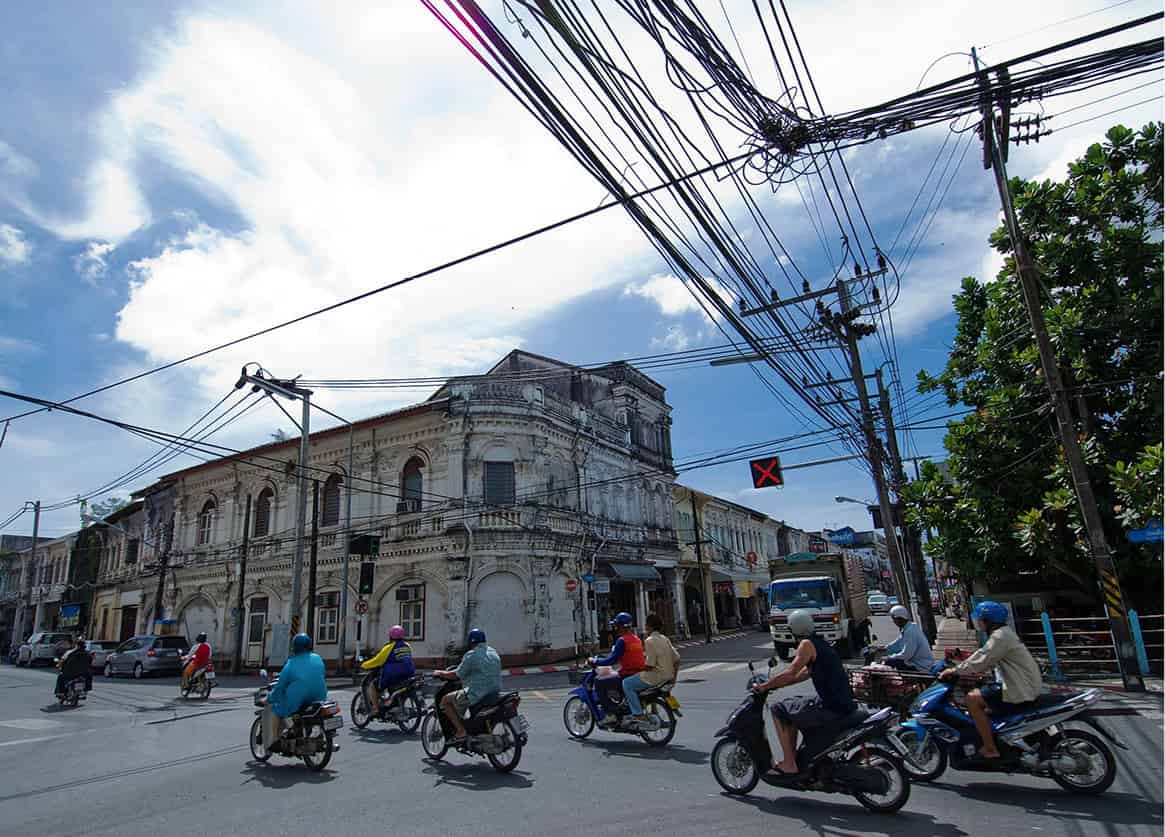
Colonial buildings in Phuket town centre.
Nikt Wong/Apa Publications
One downside to Phuket’s continuing popularity is its shrinking capacity to handle what may now be perceived as overload. Emerging tourism markets, notably Russian and Chinese, the latter of whom have recently overtaken Malaysians as the island’s most numerous visitors, have pushed airport arrivals and departures past the eight million mark. The longer the airport queues the more intense the development, which places pressure on Phuket’s natural resources – the very springs of its popularity. Commentators are now talking of the dangers of Phuket becoming an island city that feeds neighbouring attractions such as Krabi and Phang Nga. Care will be needed to maintain the allure of the Pearl of the Andaman.
Phuket Town
On arrival, many people head straight for the beaches and give Phuket Town a miss. But, only 20 minutes’ drive from Patong, the place is worth at least a day trip as there are some sights that are rich in culture and tradition. The town can seem busy and unattractive, with an impossible-to-follow one-way traffic system, but, while by car it’s easy to get lost, on foot and with the aid of a good map, it’s not difficult to navigate.
Siam Niramit and Simon Star Show
Not quite in Phuket Town but in Rassaada on the outskirts, there’s a Phuket version of Bangkok’s cultural attraction Siam Niramit 1 [map] (Wed–Mon 5.30–10pm; www.siamniramit.com; tel: 0-7633 5000). As well as facilities such as a floating market, restaurants and tableaux of village life, a spectacular one-hour show starts at 8.30pm highlighting aspects of Thailand’s history and culture. Another Rassada attraction is the Simon Star Show 2 [map] (tel: 0-7652 3192; http://simonstarshow.com; charge) in a purpose built THB130-million theatre. Its ladyboy lip-synching cabaret shows daily at 5.30pm, 7pm and 8.30pm include an underwater sequence.
Tip
Inside Put Jaw Temple are two cans filled with numbered sticks. Speak your problem aloud and then shake the cans, picking up the first stick that falls out. The number on the stick will correspond to a pigeon hole in the adjacent hall. Inside you will find a piece of paper with your fortune written on it (you need an interpreter). Fortunes are told free, but you are expected to leave a donation.
Phuket Trickeye Museum
This interactive 3D Trickeye museum 3 [map] (daily 10am–7pm; www.phukettrickeyemuseum.com; charge) located near the Pearl Hotel offers loads of family fun. The two-storey exhibition features about 100 paintings created with the use of the trompe-l’oeil technique encouraging interaction and creating great photo opportunities. It is a good alternative for a rainy day. This site is recommended to all but especially for anyone travelling with children. All visitors are asked to take their shoes off before entering.
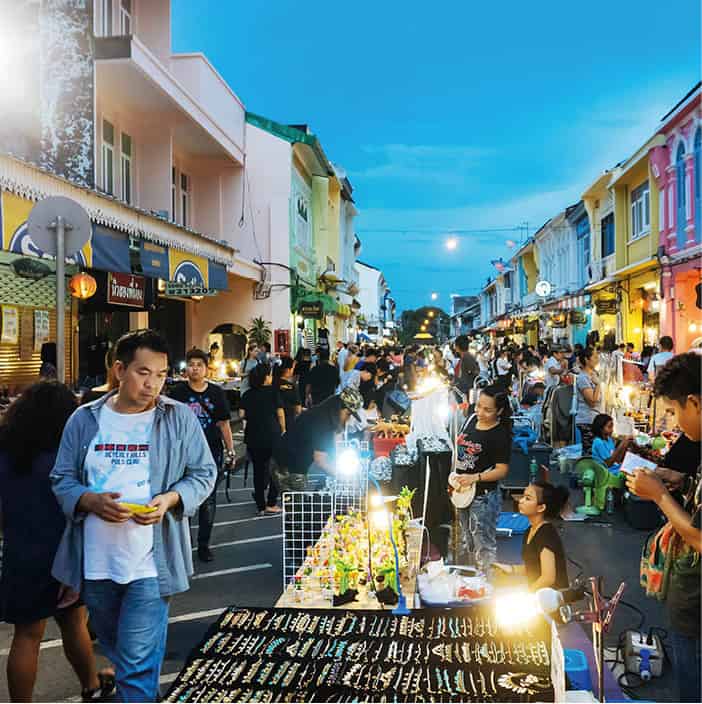
Colourful Chino Portuguese buildings along Walking Street in Phuket Town.
iStock
Khao Rang
Just south of the Butterfly Garden is Khao Rang; a spiralling road leads to a summit revealing (according to most brochures) panoramic views over Phuket town. The leafy surrounds and solitude makes it a peaceful place to have a picnic. The park is popular with locals, and is a favourite escape for young courting couples. Tung-Ka Café (tel: 0-7621 1500), at the peak of the hill, serves delicious and cheap Thai food.
Chinatown
In the heart of Phuket Town, between Thanon Thalang and Thanon Deebuk, is the Chinatown area, where old colonial houses and Sino-Portuguese-style mansions dominate, recognised by tiled roofs, artistically chiselled exteriors and tall pillars. Many are privately owned, but some are open to the public. Phra Pitak Chinpracha Mansion on Krabi Road, regarded as Phuket’s most beautiful home, now contains a branch of the international Thai restaurant chain The Blue Elephant. Many shophouses have been restored into art galleries, coffee shops and outlets for traditional Chinese herbal medicines. The Thai Hua Museum (daily 9am–5pm; tel: 0-7621 1224) on Krabi Road has wide ranging exhibits and the Thavorn Hotel Lobby Museum on Rassada Road (tel: 0-7621 1333; www.thavornhotel.com) has items ranging from tin mining paraphernalia to toy trains and opium beds.
On Thalang Road, the popular China Inn is a colourful and artistic antiques store, restaurant and garden café decorated in rich Chinese red and gold. Other cultural artefacts are found at the 80 year-old former post office on Montri Road, which is now the Phuket Philatelic Museum (open Tue–Sun 9.30am–5.30pm; tel: 0- 7621 6951).
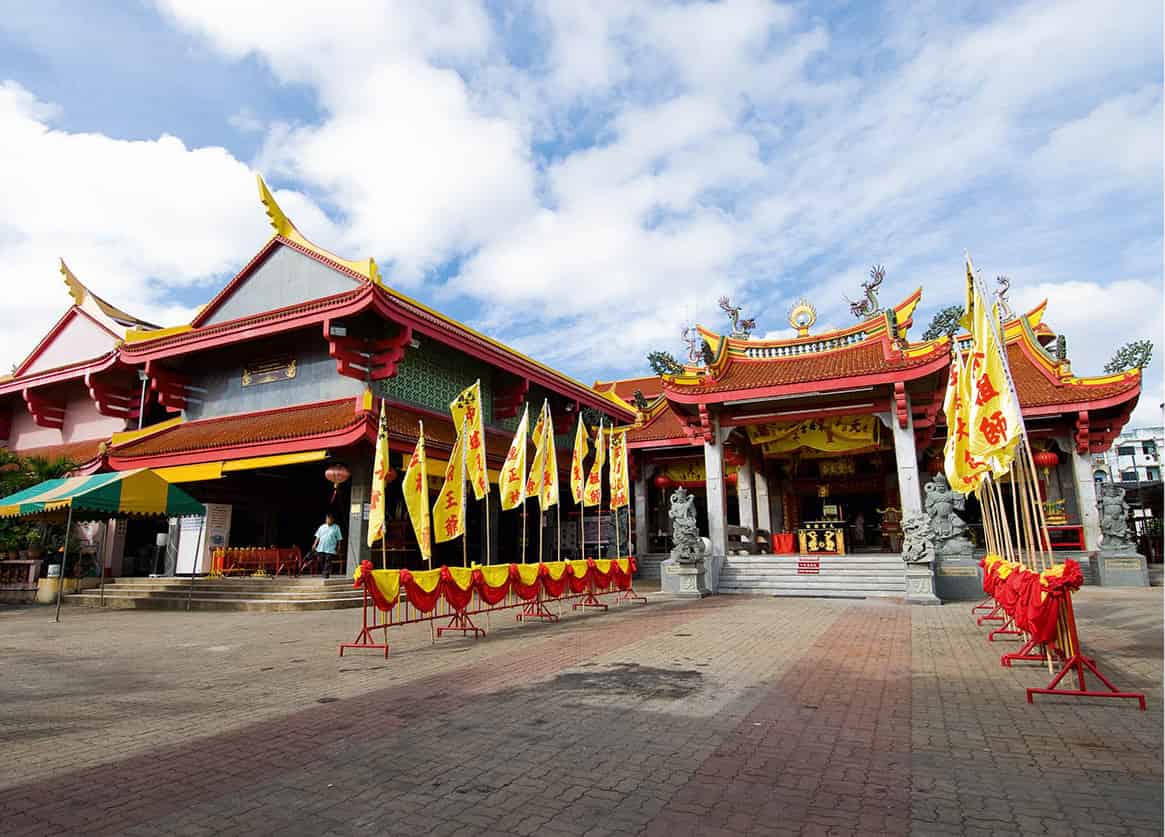
The Jui Tui Temple in Phuket Town.
Nikt Wong/Apa Publications
Chinese temples
Due to the strong Chinese presence in Phuket, a number of local temples are Taoist in character. A few in particular stand out. Sanjao Sam San (daily 8am–6pm; free) at Thanon Krabi, erected in 1853 in dedication to Tien Sang Sung Moo, the Goddess of the Sea and patron saint of sailors, is recognisable by the gold statues which stand proudly outside. Inside, intricate carvings adorn the walls.
Also worth a visit is the Put Jaw Temple (daily 6.30am–8pm; free) on Thanon Ranong, dedicated to Kwan Im, the Chinese Goddess of Mercy. At a little over 200 years old, this is the oldest Chinese Taoist temple in Phuket. Not overly impressive from the outside, it is better known for what happens within. In the middle hall, resting before an image of Kuan Im, are a number of fortune-telling devices, including a pair of wooden divining blocks, which when dropped to the floor imply a ‘yes’ or ‘no’ answer to a question – depending on which side they fall on. Your fortune can also be told by the aid of divining sticks (for more information, click here).
Jui Tui Temple (daily 8am–8.30pm; free), just next to Put Jaw, is much more ornate. On the altar inside is the red-faced statue of Kiu Ong Ya, one of the Nine Emperor Gods to whom the temple is dedicated. This temple is the main location for the annual Vegetarian Festival (for more information, click here), when the streets come alive with the thousands who flock here to witness devotees perform grotesque acts of self-mutilation.
Across from Jui Tui Temple, on the corner of Thanon Ranong, is the Central Market, where you can watch housewives as they banter with the merchants among piles of vegetables, fruit and fish. The uninitiated, however, may find the pungent scents overpowering.
Phuket’s Interior
Most visitors confine themselves to Phuket’s beaches and see little else of the island. This is a real pity as the lush interior is filled with verdant jungle-covered hills interspersed with rubber and pineapple plantations. Phuket’s compact size and relatively good roads allow you to access trails that lead through primary rainforest, take a dip at hidden waterfalls and still be back at your beach-side hotel come nightfall.
Tip
The southwest monsoon brings heavy rain from May to Oct to the Andaman Coast, including Phuket. Nov is the start of the dry season but Dec to Feb is best. Apr and May are the hottest months and Sep the wettest. Hotel rates in Phuket are the lowest from May to Oct and many people take advantage of this as there can be intermittent days of sunshine in between rainy spells.
Thalang area
About 12km (7 miles) north of Phuket Town is a large roundabout that dominates Thanon Thepkrasattri (Route 402). It is known both for its ability annoyingly to halt free-flowing traffic and for the striking statues of two women encircled by flags. Called the Heroines’ Monument, these female figures stand proud with drawn swords and honour Lady Chan and Lady Muk, the widow of the governor of Phuket and her sister, who led the successful defence of the island against the invading Burmese in 1785.
The statues mark the entry into the Thalang district. Thalang Town itself is rather run-down, but it is steeped in history, having moved to several different locations before taking up its current position in the geographical centre of Phuket in 1894.
A short distance northeast of the monument is the Thalang Museum (daily 9am–4pm; tel: 0-7631 1426; charge). The museum contains a few interesting artefacts and displays on Phuket’s past. Everything from Phuket’s prehistoric cave dwellers to the island’s invasion by the Burmese and the great tin-mining boom of the 19th century are recounted here, along with displays of its ethnic diversity as a maritime crossroads.
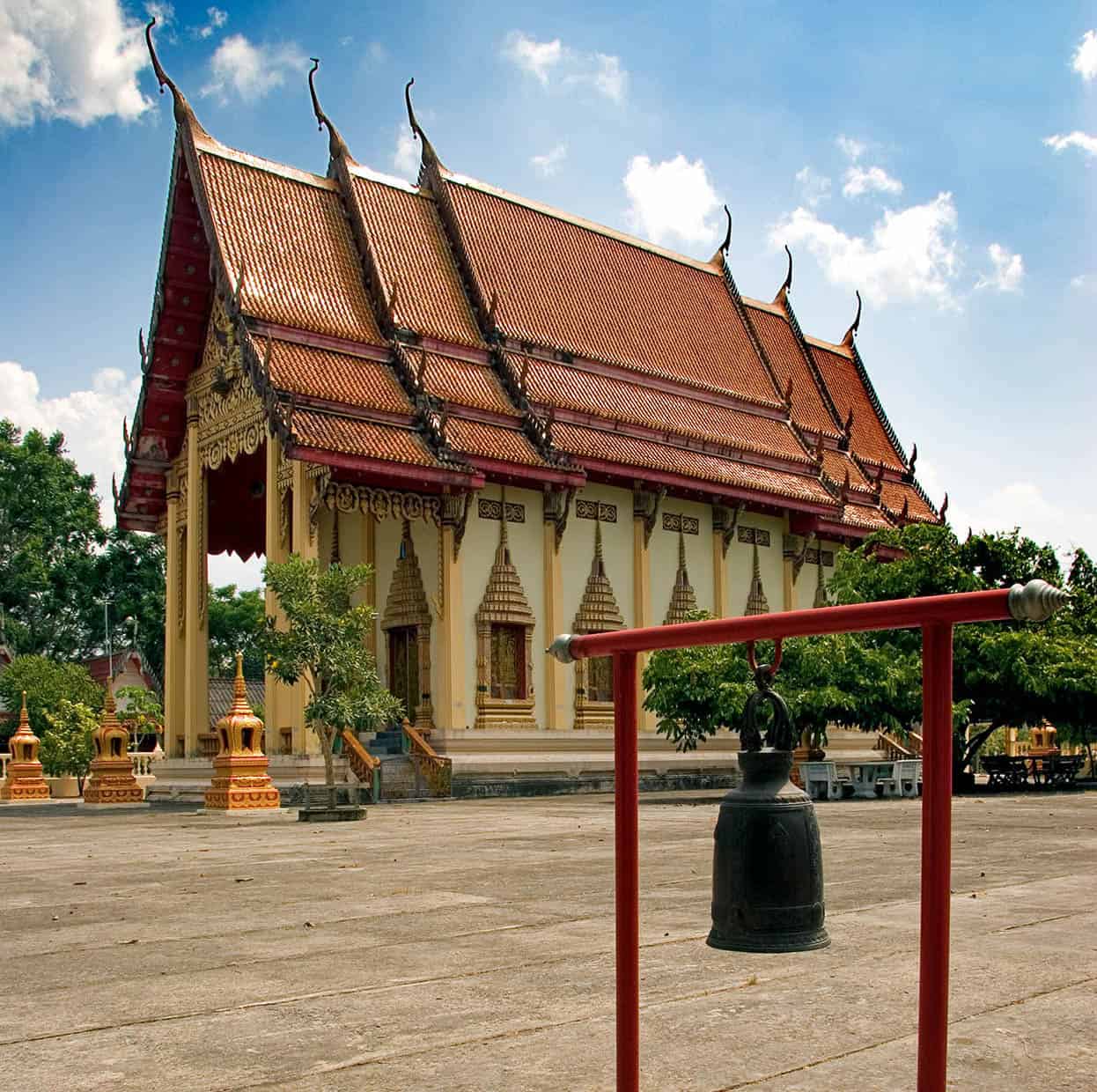
Wat Phra Thong and its half-buried Buddha statue.
Alamy
Return to Route 402 and continue to Thalang Town to see one of Phuket’s most famous temples, Wat Phra Thong 4 [map] (daily 8am–5.30pm; free), a little north beyond the main crossroads. Inside the main hall is the statue of a golden Buddha half-buried in the ground. From the chest up it measures about 2 metres (7ft). Over the years, thanks to stories circulating that the Buddha image was cast in gold, many people, including an invading Burmese army, have tried to dig it out of the ground. To date, none have succeeded in unearthing it, and most have met with grisly deaths, or so the story goes, as a result of a curse associated with the image. The statue is in fact made of brick and plaster, with a thin layer of gold covering it.
Khao Phra Taew National Park
East of Thalang Town is Khao Phra Taew National Park 5 [map] (daily 6am–6pm; charge), a pretty but hardly spectacular protected reserve. This is Phuket’s largest tract of virgin rainforest, covering 22 sq km (8.5 sq miles). A leisurely 20-minute walk from the park entrance, over some steep rocks, leads to Bang Bae Waterfall. It’s a nice spot for lunch and a swim, but is not overly remarkable as it’s neither high nor carries much water, and at certain times of year is totally dry. A further 3km (2 miles) along the same route is Ton Sai Waterfall, which, although more impressive, is also at risk of drying up during the summer months.
The rainforest is particularly lush during the May to October monsoon season, when flowers bloom and the greenery is lush. Guides are available at the information centre at the park entrance and should be used for treks. Unless you are an expert, the rare fan-shaped lang khao palms and telltale signs of wildlife are easy to miss. Tigers and bears once roamed the park, but today it is far more common to see monkeys, civets and other small animals.
Gibbon Rehabilitation Centre
A 15–20 minute walk from Bang Pae Waterfall leads to the Gibbon Rehabilitation Centre 6 [map] (Mon–Sat 9am–4.30pm, Sun until 3pm; tel: 0-7626 0492; www.gibbonproject.org; free). This is a non-profit organisation that aims to stop the poaching of Thailand’s gibbons for tourist attractions and the pet trade. The gibbons are kept in large enclosures but as the whole purpose is to reintroduce them to the wild, it’s not possible to see them up close. Although located within the national park, the Gibbon Rehabilitation Centre receives none of the money from park fees and relies solely on donations from visitors.
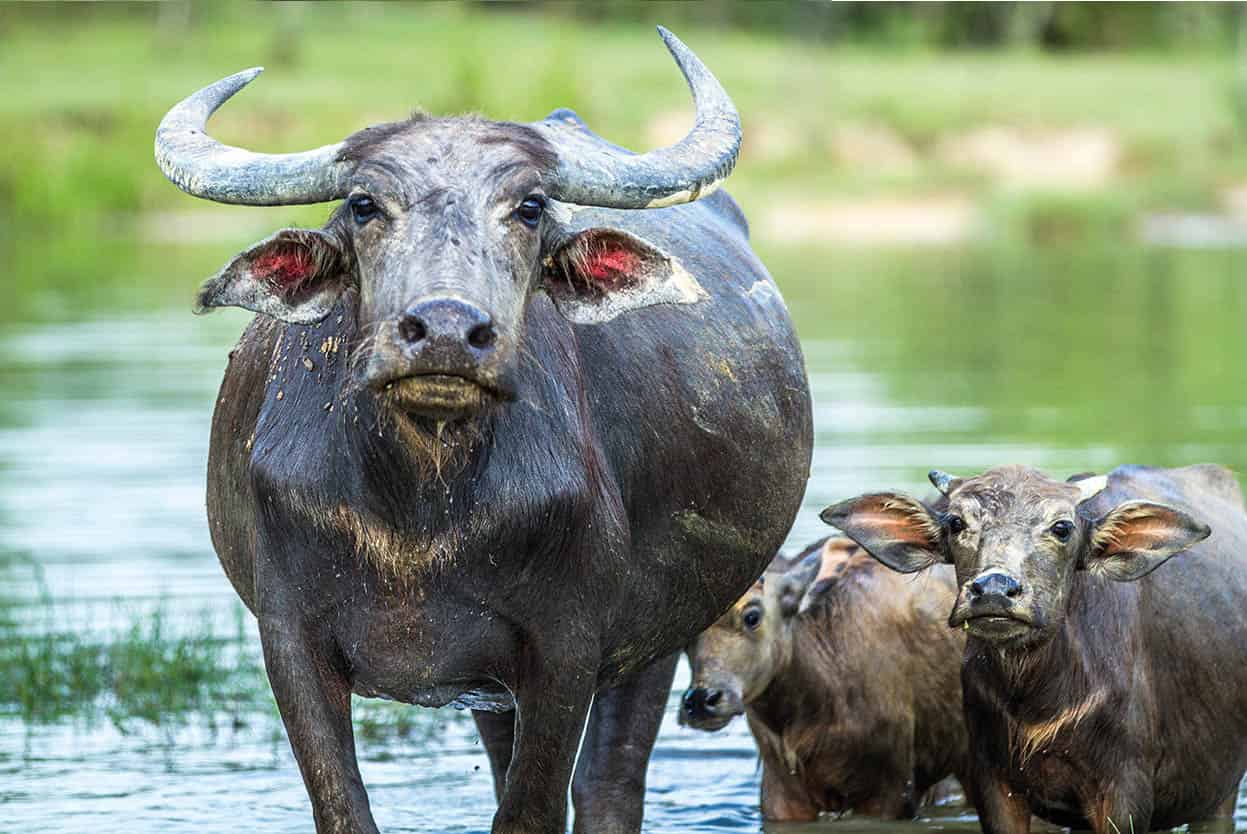
Water buffalo at Khao Phra Taew National Park.
Shutterstock
West Coast
Phuket’s western coastline is its main claim to fame. Over centuries, the coast has been sculpted by pounding waves into 16 coves stretching from north to south and carpeted in powdery white sand.
Sirinat National Park
A large chunk of the northwest cape is given over to Sirinat National Park 7 [map] (daily 6am–6pm). Formerly called Nai Yang National Park, it was renamed in 1992 in commemoration of Her Majesty Queen Sirikit’s 60th birthday. The 90-sq-km (35-sq-mile) park, of which 75 percent comprises the surrounding seas, encompasses the beaches at Hat Nai Yang and Hat Nai Thon, as well as the northern mangrove area at Hat Mai Khao.
Casuarinas are the most common trees found in the park, and many species of bird, mammal and insect live within its mangrove forests. The park’s marine environment is diverse and its coral reefs are among the most pristine found around Phuket. Located in water between 4–7 metres (12–23ft) deep are extensive plate and tree corals, as well as sea fans and sea anemones. The 600-metre (1,970ft)-long Thachatchai Nature Trail at the northern end of the park follows signs along a wooden walkway highlighting various species of flora and fauna common to this region.
Hat Mai Khao
Despite being the longest of Phuket’s beaches, at over 17km (11 miles) long, the secluded location of Hat Mai Khao 8 [map] at the top north of the island also makes it one of the quietest. The sands are more golden than white and a little coarse underfoot, but the waters are very clean. There is little to do at Hat Mai Khao other than soak up the sun. As the beach is part of the protected Sirinat National Park, development is virtually nonexistent, which is perhaps why hundreds of olive ridley sea turtles, as well as the odd giant leatherback turtle, come ashore to lay their eggs here between November and February each year.
There are several hotels on this beach, with notable names being the JW Marriott Resort & Spa and the sleek and very stylish all-villa Anantara Phuket resort located next door. The JW resort, the first to open, was initially criticised for encroaching on national-park property, but the hotel managed to change public perception by initiating the Marine Turtle Foundation. All guests who stay at the JW resort are encouraged to donate US$1 a day to support local conservation efforts that help ensure the turtles’ yearly return to Mai Khao’s pristine shores.
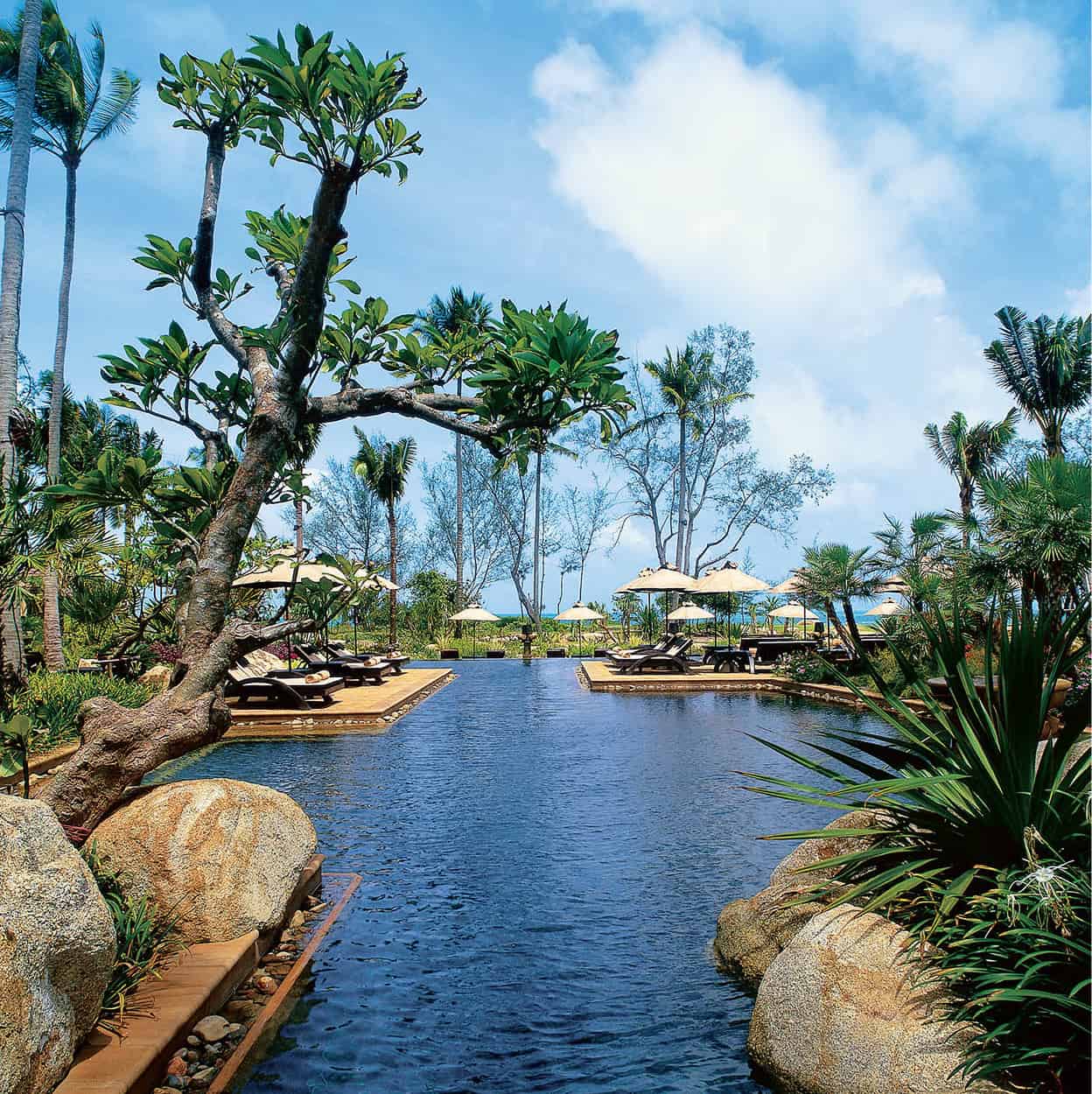
JW Marriott Resort & Spa on Hat Mai Khao.
JW Marriott Resort & Spa
Hat Nai Yang
Despite housing the headquarters of Sirinat National Park and being a protected area, Hat Nai Yang 9 [map] has a few hotels. Still, it is very laid-back and quiet compared with the beaches further down the coast. In the low season it is virtually deserted, but high season sees a strip of thatched wooden beach huts serving cold beer and seafood. The beach itself is a beautiful curving bay lined with evergreen trees that provide both visual relief and shade. A large coral reef around 1km (0.5 mile) offshore is home to many different species of fish, and Mai Khao’s nesting turtles sometimes stray on to the shores of Nai Yang as well.
Hat Nai Thon
The smallest of Sirinat National Park’s three beaches, and one of the most isolated on the island, is Hat Nai Thon ) [map], which, due to its position at the foot of a series of high hills, is harder to reach and requires a journey on a long and winding road passing jungle and rubber plantations. The beach is not totally deserted, however, and a few sun beds are available for hire. Nai Ton is sheltered from the wind and waves and offers good swimming and snorkelling along its rocky headlands, which attract rich marine life year round. Offshore are the remains of a wrecked tin dredger; found at a depth of 16 metres (52ft), a favourite spot with divers.
Tip
Even if you can’t afford to stay at the famed Amanpuri resort (by far Phuket’s most expensive), go there for lunch or a drink to soak in the ambience, architecture and views from its lofty perch at the top of a cliff.
Ao Bang Thao
The 8km (5 mile) stretch of beach at gently curving Ao Bang Thao ! [map] is dominated by the Laguna Resort, an integrated development of five luxury hotels, the most exclusive being the Banyan Tree Phuket, with its 18-hole golf course and multi-award-winning spa. With its Family Fun Zone and Camp Quest activities for children aged 8–12 years, Laguna is a popular option for family holidays. The sand on Bang Tao beach is among the whitest on the island, and the water is crystal-clear. Beware of the strong undertow, however, during the monsoon season. Accommodation runs the length of this beach, all of it thankfully low-rise, and there are several restaurants and antique shops.
Ao Pansea and Hat Surin
One of Phuket’s most exclusive resorts, the luxury Amanpuri occupies prime position at Ao Pansea @ [map], with Thai-style pavilions interspersed in a coconut plantation. This hotel is the preserve of both the mega-rich and a host of A-list celebrities.
Although the law in Thailand states that all beaches in the country are public, Pansea seems to be one of several exceptions, helped by the fact that it is closed off by headlands at each end. The other end of Ao Pansea is anchored by 5-star The Surin Phuket resort, which is much more affordable, but still beyond the reach of many.
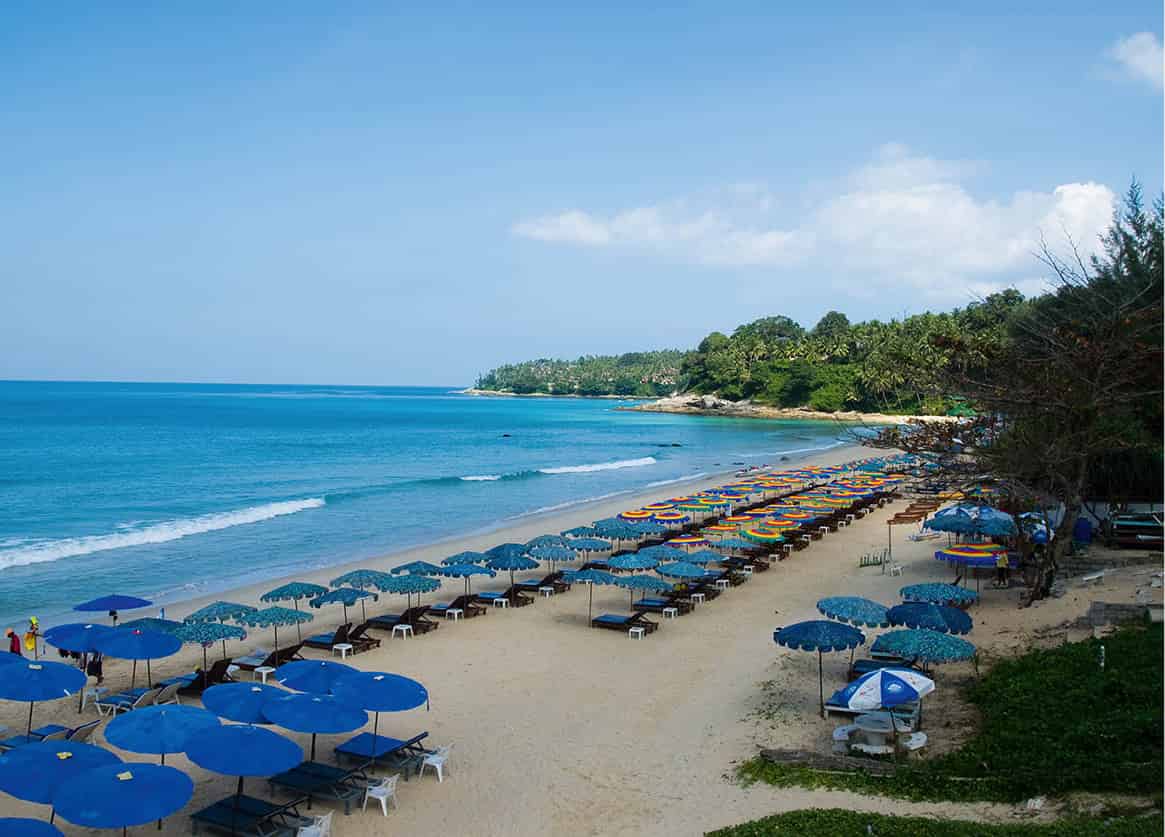
Hat Surin is pretty, but be careful of the undertow during the monsoon season.
Nikt Wong/Apa Publications
Beyond the resort, the beach becomes Hat Surin £ [map], where the sand is more of a golden hue than white. There are many luxury private villas here, while the Twin Palms resort dominates the beach and charges exhorbitant prices for loungers. However, there is still a local feel to the place, with vendors at makeshift stalls selling freshly grilled prawns and barbecued mackerel, but there are now several restaurants, too. Again, beware of the undertow during the monsoon season.
Hat Kamala
High-profile Patong received the most coverage when the tsunami hit Phuket in December 2004, but it was the quieter Hat Kamala $ [map] that took the brunt of the killer waves. Damage to this area of mostly Muslim villages was severe and the area took longer to recover than any other in Phuket. Kamala is only a few minutes away from the hustle and bustle of Patong yet could not be more different in character; the beach is calm, relaxed and peaceful, with few vendors touting for business. Headlands to the north and south shelter the beach, and with forested hills rising inland, the overall effect is a very picturesque bay. Kamala retains something of a village atmosphere.
In the heart of Kamala is the Phuket Fantasea % [map] (daily Fri–Wed 5.30–11.30pm, show time 9pm; tel: 0-7638 5111; www.phuket-fantasea.com). The 57-hectare (140-acre) complex, which cost a massive US$60 million to construct, touts itself as a night-time cultural theme park. Visitors can pose for photos while riding elephants and cuddling tiger cubs, although the latter are quickly taken from you after the flash goes off and passed on to the next paying customer. The show itself combines high-wire trapeze acts, acrobatics, pyrotechnics and illusions, traditional dance, and a whole menagerie of performing animals, including at one point over 40 elephants on stage all at the same time.
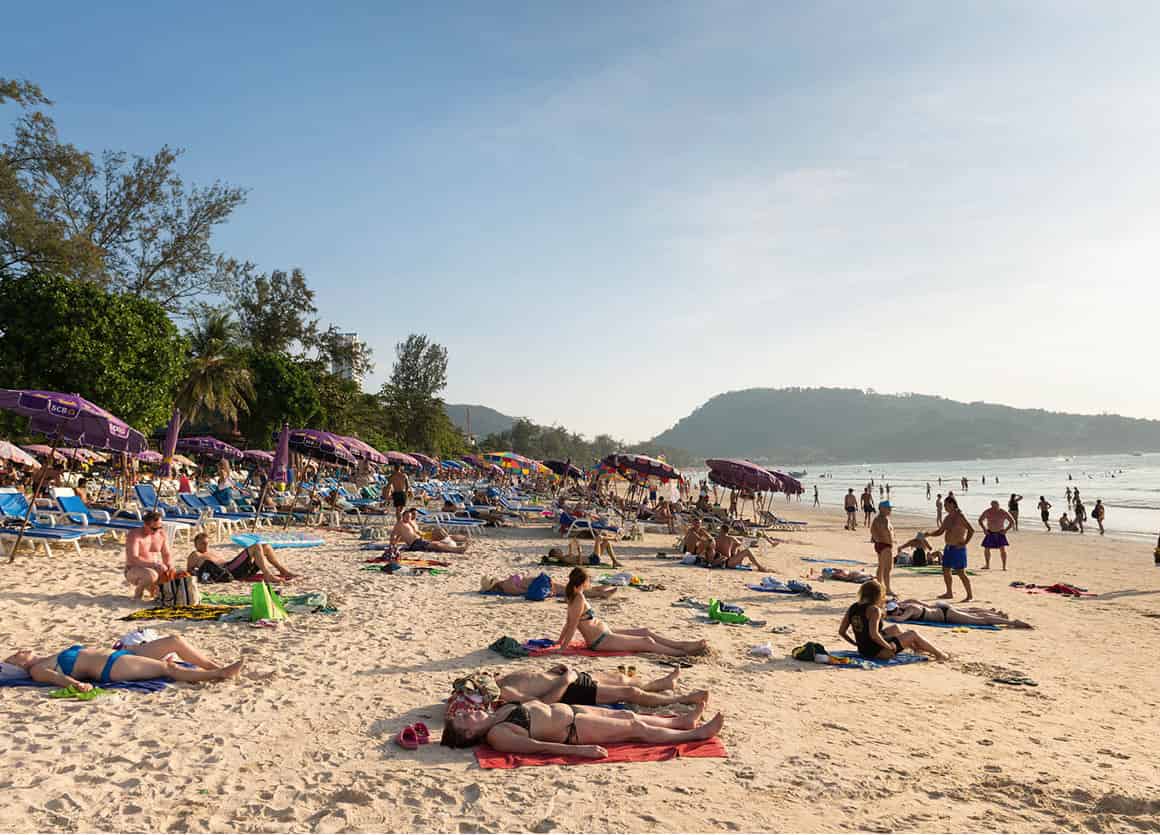
Hat Patong is by far Phuket’s busiest beach.
Bigstock
Hat Patong
For every person drawn to Hat Patong ^ [map]. there is another who can’t escape quickly enough. But, love it or hate it, Phuket would not be the tourist magnet it is without its multitude of shops, restaurants, street stalls, neon lights, flashy bars and discos. The beach is crowded with sunburnt bodies sheltered under rows of beach umbrellas – even in the low season it is virtually impossible to find a quiet spot on the sand – and the constant barrage of hawkers gets annoying, with touts from restaurants and tailors going overboard to entice you into their shops. On the plus side, the location is naturally beautiful: the sea is crystal-clear outside of the monsoon season, and is good for swimming or snorkelling (although care should be taken not to get too close to the jet-skis and banana boats whizzing by close to the shore). Also beware the scams associated with hiring these craft (for more information, click here).
Tip
There is plenty to spend your money on, with lots of variety. The range of cuisines on offer is immense and caters for every palate. While the nightlife in certain areas is seedy and the prostitution blatant, you can have a fun and entertaining night if you don’t take it all too seriously. There are transsexual cabaret shows, plenty of bars, running from Thai-style to the ubiquitous Irish-themed pubs, and a few decent dance venues.
As Patong was developed early into a more commercial centre, it doesn’t have the benefit of the beachside resorts found in other locations, and only one hotel, Impiana Resort Patong, is right on the beach. All other properties are tucked behind the beach-side Thanon Thaveewong.
Patong nightlife
In the heart of Patong is Soi Bangla, the epicentre of the seedy sex trade with bar after bar of young Thai prostitutes, kathoey, or ‘lady-boy’ transsexuals, and the explicit ‘ping-pong’ sex shows. Despite the blatant commercial trade, the atmosphere is relaxed and feels surprisingly safe. While single men may get hassled to buy drinks for the bar girls, women, couples and even families can amble down the street, stop in a bar or two and be treated no differently than they would elsewhere on the island. Patong also has a fairly large gay district, featuring everything from sex-orientated places to gay-friendly hotels, bars and cafés that mainly centres around the network of lanes that make up the Paradise Complex near the Royal Paradise Hotel on Thanon Raja Uthit.
Patong’s version of Thailand’s popular transsexual cabaret shows is Simon Cabaret (show nightly at 6pm, 7.30pm and 9pm; tel: 0- 87888 6888; www.phuket-simoncabaret.com; charge), located on Thanon Sirirat heading south out of Patong. While some people find the show rather dull, with the performing ‘lady-boys’, or kathoey, miming the lyrics and acting and dancing flamboyantly, it has a Vegas-style glitz that draws people in every night.
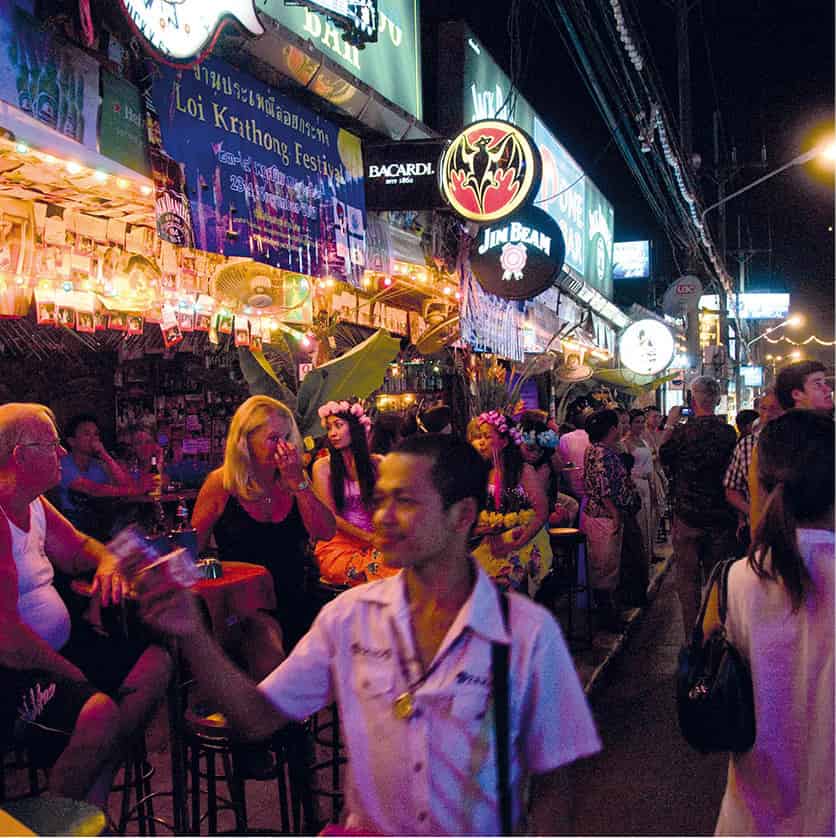
Patong’s Soi Bangla comes alive at night.
Nikt Wong/Apa Publications
Hat Karon Noi and Hat Karon
Past Hat Patong is Hat Karon Noi, sometimes referred to as Relax Bay. Although it is a public beach, this crescent of sand is dominated by a single hotel, Le Méridien Phuket, making access to it a little difficult.
Further south is the 4km (3-mile)-long beach at Hat Karon & [map], which, despite being Phuket’s second-most popular beach after Hat Patong, is rarely packed. The sand is golden in colour and its beauty is only slightly tarnished by the ugly sand dunes and grassy embankment leading up to the road backing it. It was this elevated position that spared Karon from the same degree of tsunami devastation that Patong suffered. During the rainy season, large waves make Hat Karon excellent for surfing but unsafe for swimming. There is a good range of hotels, most of which, like in Patong, are tucked behind the beach-side Thanon Karon.
One of Karon’s most prominent attractions is the kitsch Dino Park and Mini Golf (daily 10am–11pm; tel: 0-7633 0625; www.dinopark.com; charge). It is impossible to miss this sight with its huge dinosaur statue towering outside and staff dressed in Flintstone costumes. At night, an elephant stands at the entrance, waiting to be fed bananas. The tables are carved out of stone and set among pretty waterfalls and jungle vines, but the food is overpriced and tastes bland. More impressive is the mini golf course (18 holes), which trails over rocks and across rivers, passing screeching dinosaurs with smoking nostrils and clusters of half-hatched eggs.
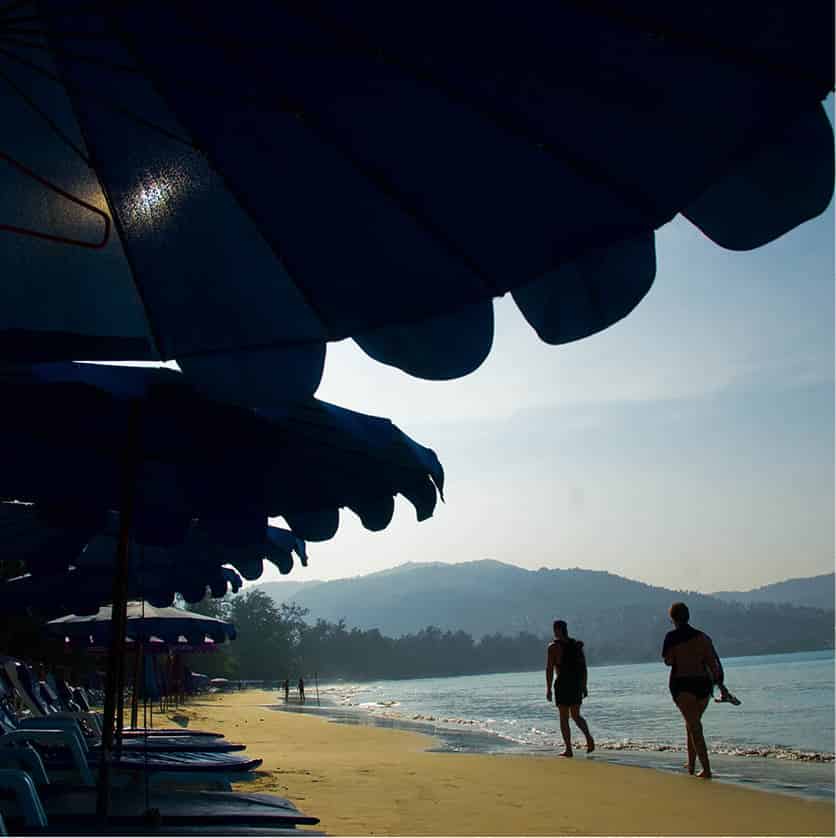
It is easy to see why Hat Kata Yai is one of Phuket’s best beaches.
Nikt Wong/Apa Publications
Hat Kata Yai and Hat Kata Noi
Just past the headland from Karon is Hat Kata Yai * [map] (mostly referred to only as Kata), arguably one of the most scenic of Phuket’s beaches and the reason why Club Med chose to open its resort here. This lovely beach is blessed with white sand and clear waters good for swimming and snorkelling. As a result, it is very popular and, being relatively small, can get busy. At night, it is quiet and romantic, and there are a number of seafood restaurants lit by fairy lights overlooking the waves lapping the shore. The southern end of the beach is home to The Boathouse hotel, which has a well-known fine-dining restaurant.
Separated by a rocky headland is Hat Kata Noi ( [map], which shares the same white sand and clear blue-green waters as the preceding beach but is even prettier and more peaceful. The sprawling but unattractive Katathani Phuket Beach Resort has almost complete run of this beach. At the southern end of the beach are some decent corals for snorkelling.
Kata Hill Viewpoint
Cars sometimes struggle and motorbikes splutter trying to crest the sharp, steep mountain road that leads out of Kata. On a sunny day, the view from this road is breathtaking. There are a couple of small bar-restaurants here that play reggae and soft rock music. Built on simple wooden platforms over the hillside looking towards the sea, both are good for watching the setting sun.
A little further along on the opposite side of the road is Kok Chang Elephant Camp (tel: 08-9591 9413). Visitors can arrange to go on elephant treks (20, 30 or 50 minute rides are available), or just feed the elephants bananas or pineapples, and stop for a refreshing drink at the bamboo bar at the front of the park, where they will often be joined by two resident monkeys.
At the peak is the Kata Hill Viewpoint , [map], from which the three stunning bays of Kata, Karon and Patong can be seen in one fell swoop. This famous scene appears on postcards island-wide; photography conditions are better in the morning, as even on a seemingly perfect day, the clouds can roll in by mid-afternoon and block the view.
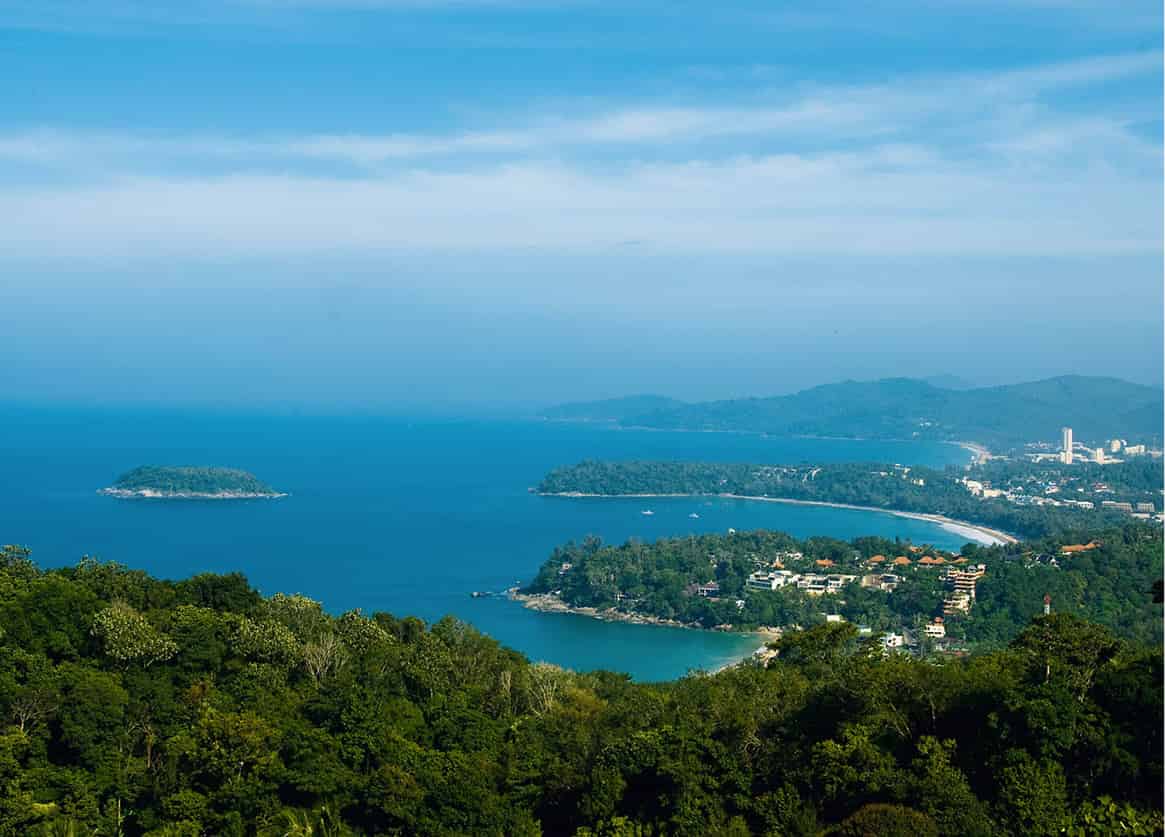
Aerial view of Kata, Karon and Patong beaches from the Kata Hill Viewpoint.
Nikt Wong/Apa Publications
Hat Nai Harn
South of Kata and lying between two ridges is stunning white-sand Hat Nai Harn ⁄ [map], the epitome of a chilled and laid-back Thai beach. For this it can thank the Samnak Song Nai Harn Monastery, which occupies a large portion of the seafront land, and has therefore thwarted development. Nai Harn, backed by an open lagoon, is a quieter alternative to the island’s other beaches and is popular with expats, who are frequently seen exercising their dogs on Sunday mornings. It offers some conveniences in the form of a few small bars, restaurants and shops. An open lagoon, the cause of much controversy when the trees bordering it were ripped out in early 2005, backs the beach. The trees were cleared to make way for what is now a jogging track, and the surrounding grounds re-landscaped.
Eat
The views at Promthep Cape Restaurant (tel: 0-7628 8656; daily lunch and dinner; www.phromtheprestaurant.com) are much better than the mostly mediocre food, of which the most impressive are the fresh oysters, reared in the owner’s farm. Service is slow, but the staff are friendly and the prices reasonable.
South Coast
The south-coast beaches from Laem Promthep onwards are largely mediocre at best and mainly used as a staging point for explorations of the islands off the southern coast.
Laem Promthep
Leading up the mountain from Nai Harn is another viewpoint that features on many a postcard of Phuket, Laem Promthep ¤ [map] (Promthep Cape). This busy point overlooking a splendid headland stretching into the blue Andaman Sea is packed every evening throughout the year when hordes of tourists flock to see the sun sink slowly over the horizon. When the conditions are right, the sunset vistas here are wonderful. Promthep Cape Restaurant, overlooking the cape and serving cheap Thai food, is surprisingly quiet considering the number of visitors.
Tip
Phuket is the sailing centre of Thailand, with several regattas throughout the year, including the King’s Cup, held every December around the king’s birthday. Ao Chalong is where most boats dock and the Ao Chalong Yacht Club (tel: 08-5249 0823; www.acyc.asia) holds regular races. The clubhouse is a good place to meet people and find out about crewing opportunities.
Hat Rawai
A base for the vast majority of Phuket’s foreign residents, Hat Rawai ‹ [map] offers all the attractions of island life but without the intrusive tourist facilities of Kata, Karon and Patong. Rawai is often picturesque, with its rows of small fishing and longtail boats waiting to journey to the nearby islands, but at low tide, the exposed rocks make it unsuitable for swimming and snorkelling. Rawai is famous for its street vendors who barbecue freshly caught seafood along the beach road throughout the day and the fresh seafood restaurants that open in the evenings. To the south of the beach is a small chao lay (sea gypsy) village that can be visited.
Nearby, on Thanon Viset, is the Phuket Seashell Museum (daily 8am–6pm; tel: 0-7661 3666; charge), with an interesting display of over 2,000 different species of shell and fossil; some of the latter are reputedly over 380 million years old.
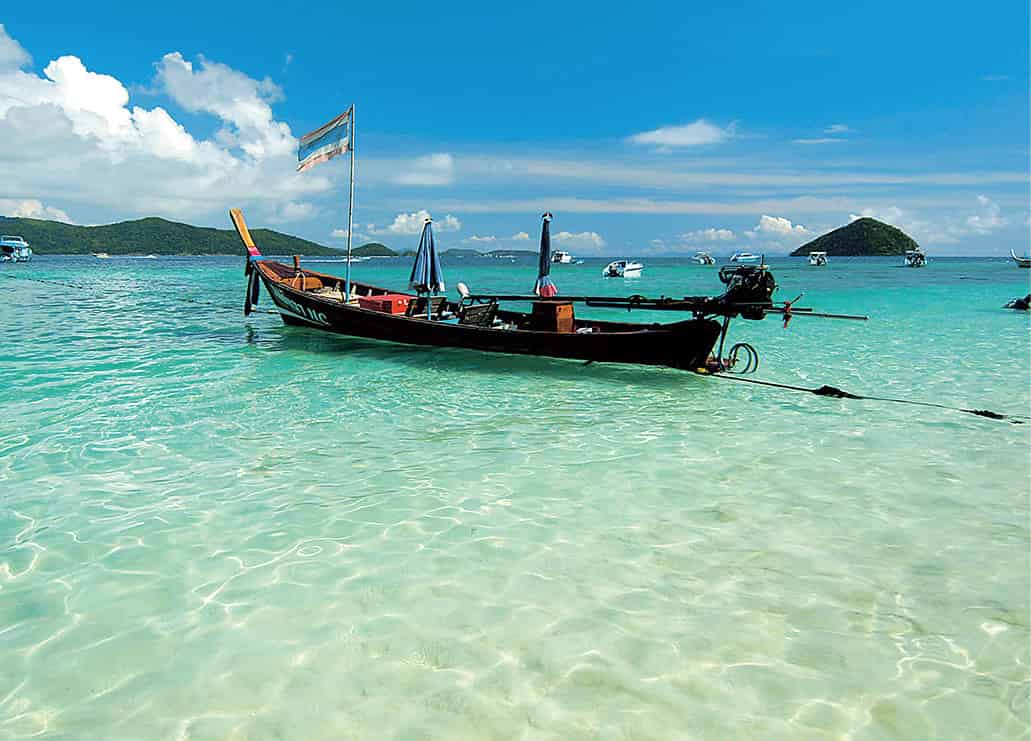
Ko Hae, also known as Coral Island.
John W. Ishii/Apa Publications
Ao Chalong
North of Rawai is Ao Chalong, which is known mainly for a temple, a huge Buddha statue, and a pier, from which many scuba expeditions and boat trips to nearby islands depart. The massive 45-metre (150ft) Buddha statue dominates the area from atop Nakkerd Hill, and is worth visiting for vistas across the sea and southern tip of Phuket. The new Chalong Bay Marina launched in 2015.
Wat Chalong › [map] (daily 7am–5pm; www.wat-chalong-phuket.com; free), located inland of Rawai on Route 4021, is Phuket’s most important Buddhist temple and the largest of the island’s 29 Buddhist monasteries. Architecturally, it’s not that different from other Thai temples, but it is one of Phuket’s most ornate and among the most visited by both Thais and foreigners. The temple is associated with the revered monks Luang Pro Chaem and Luang Pho Chuang, famous herbal doctors and bone-setters who tended to the people of Phuket during the tin miners’ rebellion of 1876. Far from being just physical healers, they also mediated in the conflict, bringing both parties together to resolve disputes. Today, many Thais visit the temple to pay homage to the two statues that honour the monks.
Phuket Botanic Garden (Tue–Sun 9am–5pm; tel: 0 7636 7095; www.phuketbotanicgarden.com; charge) displays various exotic and tropical plants. With more than thirty theme zones, an artificial waterfall, a restaurant and a small butterfly garden, it is a worthwhile alternative to the beach. The orchid and cactus gardens are especially worth taking the time to explore.
Southern Islands
The waters around Phuket’s southernmost tip are dotted with a number of islands. All can be reached by the longtail boats lining Hat Rawai beach or the pier at Ao Chalong. If staying overnight at islands such as Ko Racha, the resort there will arrange the boat transfer for you.
Ko Bon
Nearest to shore is the small but pretty Ko Bon fi [map], which can be reached in just 10 minutes. Unfortunately, Ko Bon has no rooms for rent and no fresh water or electricity for visitors to stay overnight but the idyllic beaches are worth making the day trip for.
Most day-trippers head for diving and snorkelling on the other side of the island, where the Bon Island Restaurant, a small Thai seafood place, is all that rests on the sandy beachfront. Some of the coral close to shore was damaged by the 2004 tsunami, and larger fragments are still strewn on the beach, too heavy to be moved (but actually look quite pretty). Coral in the deeper waters remains undamaged, and the water in front of the Bon Island Restaurant is particularly good for snorkelling.
Ko Hae
About 20 minutes from mainland Phuket, and often combined on a day trip with Ko Bon, is Ko Hae fl [map] (Coral Island). Amenities are better than at Ko Bon, with a number of restaurants, a few small shops and a choice of water sports. Overnight stays are possible at the Coral Island Resort (www.coralislandresort.com; tel: 0-7628 1060), the island’s only accommodation; nights are generally very quiet when all the day-trippers have returned to Phuket. The crystal-clear turquoise waters around the island make it particularly good for both swimming and snorkelling, and there is a shallow coral reef within easy swimming distance of the beach.
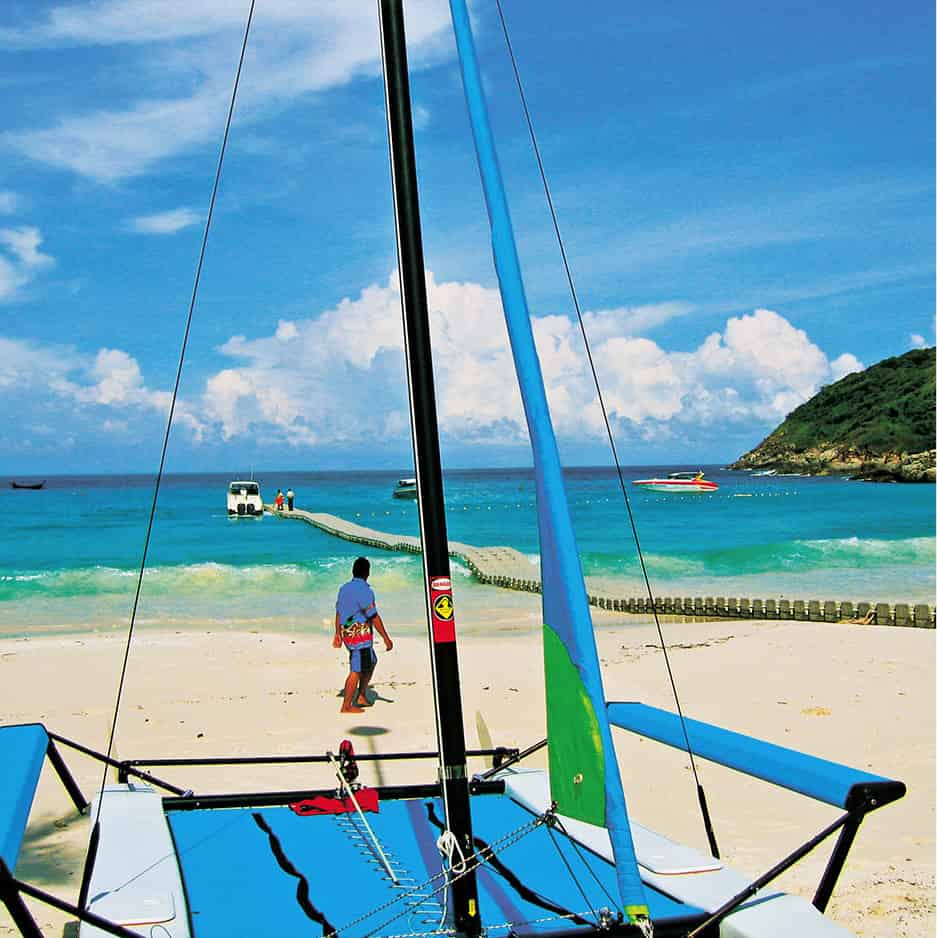
Pristine Ao Batok on Ko Racha Yai.
John W. Ishii/Apa Publications
Ko Kaeo
Despite being only a 10-minute boat ride from mainland Phuket, Ko Kaeo ‡ [map] is by far the least-visited by day-trippers due to its lack of facilities, giving them the chance to have their own private beach for the day. The pretty island is home to a number of Buddha statues and shrines, hence its name, which translates as Buddha Island.
Ko Racha
Around 20km (12 miles) off the coast of Rawai are Ko Racha Noi, a small uninhabited island with more rocks than beaches, and the larger Ko Racha Yai ° [map]. Of the many islands within close proximity of Phuket, Ko Racha Yai is one of the most exclusive, as it’s the site of a luxury resort known simply as The Racha (www.theracha.com), on the northeast coast along Ao Batok. High season sees Ko Racha Yai transform into a bustling hotspot, with day-trippers arriving on longtail boats and filling the beaches. The shoreline of the beach in front of The Racha is picturesque, the sand almost talcum powder-like and the waters crystal-clear turquoise. Watch out for the small corals and rocks, however, when you wade into the waters.
Ko Racha offers some of the best diving in the Phuket area, and as the going is generally free of hazard, it’s suitable for all levels. The islands are often compared to the waters around the Similan Islands. The Bungalow Bay reef offshore of Ao Batok has clear waters and soft coral gardens, with good visibility and currents that allow gentle drift diving along sloping reefs. Elsewhere on the island are more white-sand beaches and snorkelling spots. Resting at the bottom of a grassy slope on the eastern coast is Ao Kon Kare, a small sandy beach with Lucy’s Reef within swimming distance, a nickname given to the staghorn coral found here. Further up the east coast, a submerged wreck is found off Ao Ter at depths of 25–35 metres (80–115ft); it is popular with more advanced divers. On the northern coast is Ao Siam, where shallow waters not only make for good snorkelling but also prevent boats from docking, keeping this beach less busy than those in other parts of the island.
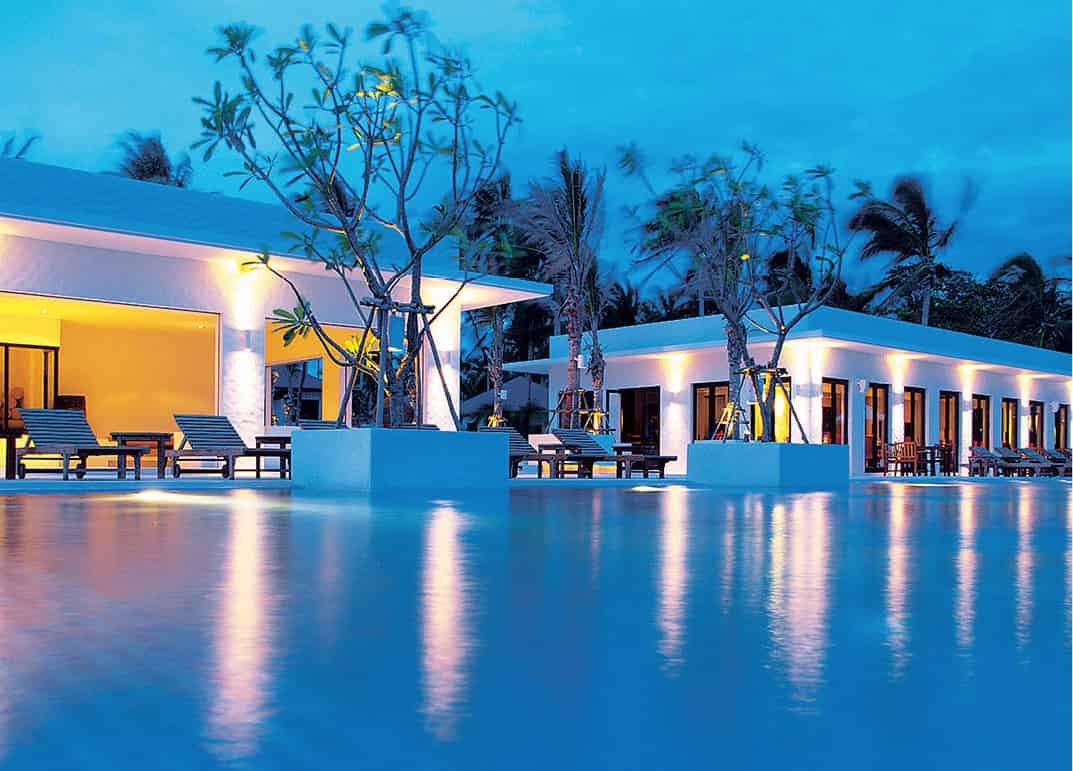
Poolside at dusk, The Racha resort.
The Racha
The smaller Ko Racha Noi also has a few good dive sites for experienced divers; depths here are generally greater and currents stronger. On the southwest side of the island, lots of interesting reef fish are drawn to a 27-metre (88ft) shipwreck, while a large pinnacle at the northern tip attracts stingrays and reef sharks.
Phuket’s other dive sites are scattered around the Andaman Coast (for more information, click here).
East Coast
The east coast of Phuket was once the bank of a flooded river. Unlike the west, this side of the coastline comprises mainly limestone shoals and virtually no sandy beaches.
Laem Panwa
The only real beach spot on the eastern coast of Phuket is Laem Panwa, 10km (6 miles) southeast from Phuket Town. This quiet cape is frequently filled with yachts sailing around Ao Yon · [map], where a totally unspoilt stretch of sand sheltered by headlands on both sides makes it a good spot for swimming all year round. Only a handful of hotels and restaurants stand in the Laem Panwa area, and as tuk-tuks and motorcycle taxis rarely journey over the winding mountain road to get here, the beach is often deserted.
Tip
Visits to minority communities have become very much a part of the tourist experience, and many villages adapt well. But this is not always the case. If visiting Ko Sirey sea-gypsy village, please consider the inhabitants, who may not be in the mood to be a photo opportunity.
Khao Khad Viewpoint (reached by following signs along Thanon Sakdidej, which lead through Muang Tong village) is a beautiful spot from which to gaze out to the sea. From this elevated point, Phuket Town lies to one side, Chalong Bay to the other, and the shadowy outline of Ko Phi Phi (for more information, click here) island can be seen in the distance.
On the southernmost tip of Laem Panwa, on Route 4129, is the Phuket Aquarium & Marine Biological Research Centre (daily 8.30am–4.30pm; http://phuketaquarium.org; tel: 0-7639 1126; charge). The impressive display of sharks, tropical fish, reefs and a touch pool with starfish and sea cucumbers makes an excellent primer before taking that first diving or snorkelling trip. There’s also a nature trail to learn about coastal habitats.
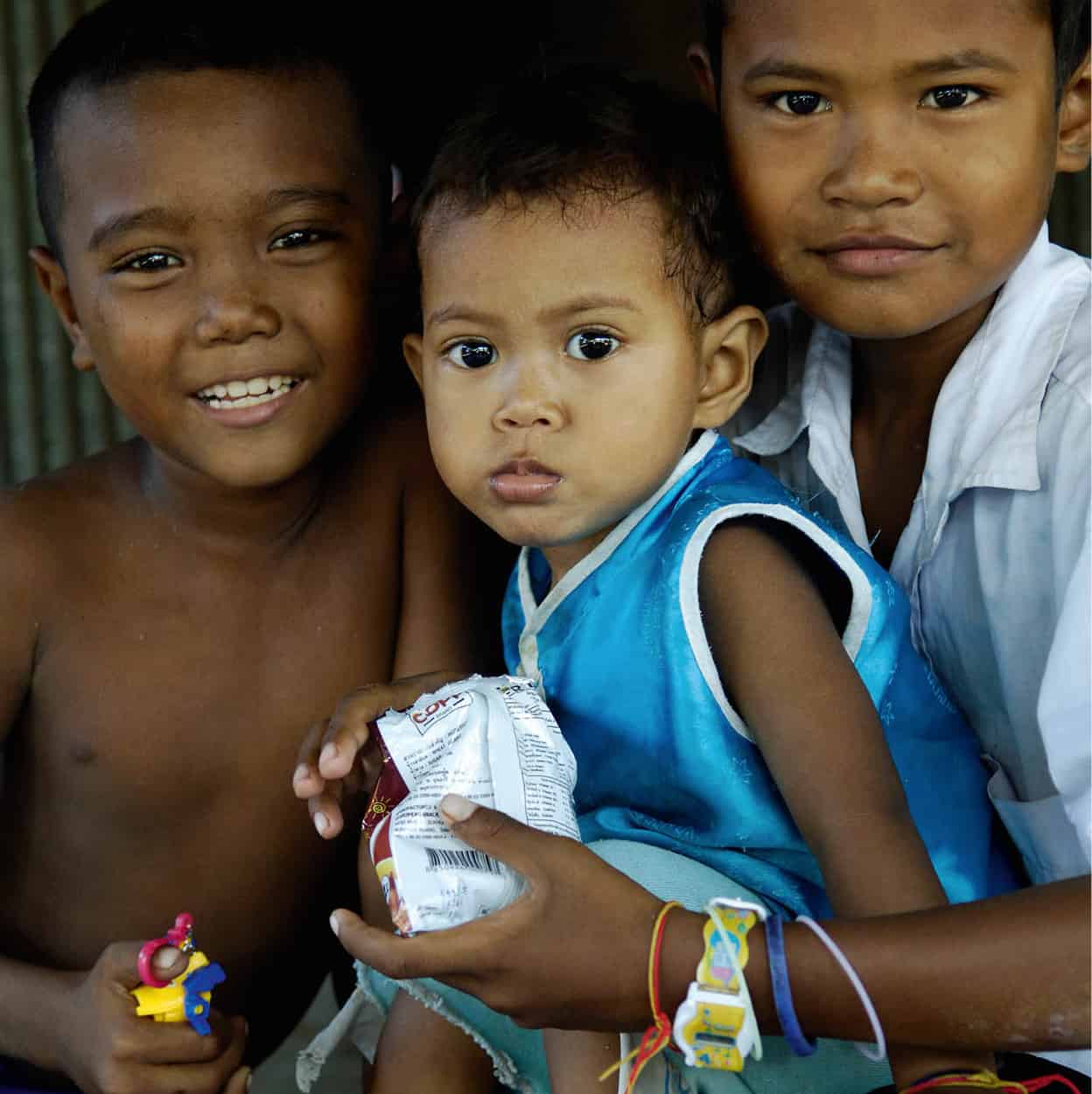
“Sea gypsy” children.
John W. Ishii/Apa Publications
Ko Sirey
To the east of Phuket Town, and separated from the mainland by a small bridge, is the tiny island of Ko Sirey º [map], home to a small chao lay (sea gypsy) fishing community. The area is poor in terms of material wealth but rich in cultural appeal. Be sure to ask permission if taking photographs. It was planned to make the island’s life more accessible with a Sea Gypsy Cultural Centre. The building was erected but its development later abandoned. Now the government plans to rebuilt the centre according to the sea gypsies’ needs.
There is a small beach on the eastern side of Ko Sirey, known as Hat Teum Suk. It is not really a swimming beach, however, and is visited mostly by Thai families.
Naga Pearl Farm
The jetty at Ao Po, north of Phuket Town, is the departure point for the 30-minute boat ride to the island of Ko Nakha Noi ¡ [map]. This is where you will find the Naga Pearl Farm (daily 9am–3.30pm; tel: 0-7742 3272; charge), where full-sized South Sea pearls worth thousands of pounds are cultivated. Also on display here is a replica of the world’s largest pearl, the original of which is currently housed at the Mikimoto Pearl Museum in Japan. Visitors can wander round and see pearls at various stages of cultivation, from the nurturing of the baby oysters to the extraction of pearls from their shells years later. Longtail-boat operators at Ao Po can arrange a boat ride to the island (about THB300 per person for a return trip) or else book a guided tour directly with the farm.
